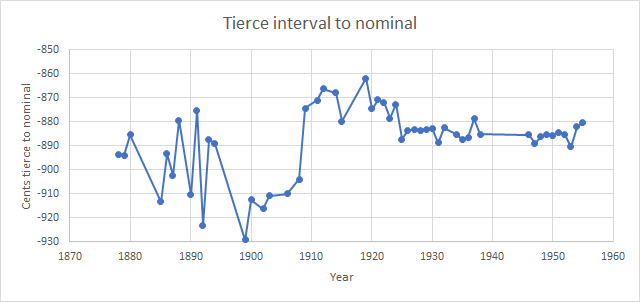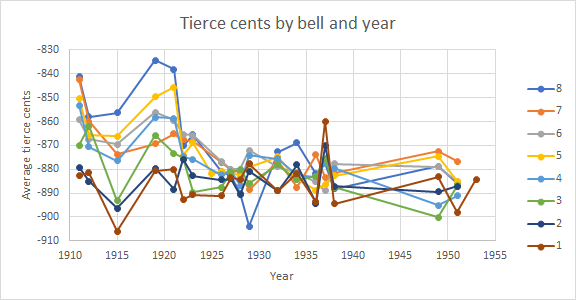This article follows a similar pattern to the corresponding article on Taylors. That article gives the technical background, which is only summarised here. The assumption on which the investigation rests is that the interval between the tierce and nominal partials in a bell is determined by the shape of the bell and can only be marginally influenced by the bell tuner. As a result, changes in the interval between tierce and nominal are an indicator of design changes in response to advances in moulding and tuning, and business opportunities for the foundry.
The history which informs this investigation relies heavily on Jill Johnston’s book England’s Child (ref 1). The firm of Gillett and Bland, later Gillett and Johnston, was founded by clockmaker William Gillett in 1844. Cyril Johnston’s father Arthur bought a partnership in the firm in 1877, about the time they cast their first bell. Cyril Johnston joined the company in 1902. In 1905 Cyril purchased a tuning machine (apparently out of his own pocket) and began to work on bell designs that could be tuned true-harmonic, basing his work on the two papers On Bell Tones and On Bell Tones II written by Simpson.
In 1906 the company installed a light chime of five at Elstree School, which were condemned by William Wooding Starmer, who recommended they be recast (by Taylors, though this is not stated explicitly). Instead, Cyril Johnston began to experiment with bell designs and in 1907 recast the Elstree bells, which were claimed as the foundry’s first true-harmonic bells – they have now been dispersed.
By 1919 the company had a large set of tuning forks (see the account of these forks on another page). Peals of bells had been cast since the end of the 19th century, and from 1910 onwards were produced in increasing numbers. In 1920 the first carillon was cast and installed in the works – nothing of this survives – and in 1921 a carillon was cast for the Toronto Metropolitan Methodist Church which was the first carillon shipped to a customer. The company went on to cast at least 53 carillons, including the heaviest in the world at Riverside, New York and at Chicago.
Cyril Johnston resigned from Gillett and Johnston in 1948 and died two years later, having been awarded an OBE for his work in bells. The foundry continued casting bells until 1957, when it closed – though the firm of Gillett and Johnston continues the clock business.
The tierces of Gillett and Johnston bells
The history shown by the plot of tierces below is simpler than that for Taylors, but no less interesting. What is plotted below is the tierce interval in cents, averaged for each year. An equal tempered minor third tierce would be 900 cents below the nominal, a just tierce rather sharper at around 880 cents below the nominal. A major third would be 800 cents below the nominal. The plot below comprises 811 bells.

In the period from 1877 to the early 1900s, tierces of Gillett and Bland and Gillett and Johnston bells show enormous variation – far more than the corresponding period for Taylors. After 1900 the variation is reduced, and in 1908/9, in the above graph, there is a dramatic change in design with tierces getting significantly sharper, no doubt as a result of the Estree experiments. From this time until the early 1920s, the average tierce is quite sharp, but the averaging hides some interesting detail as will be seen below. From the early 1920s onwards the average tierce becomes very consistent at around 885 cents below the nominal. Sometimes individual bells disrupt the average, as in 1937 where the upward blip is due to the treble at Brockham Green which has an unusually sharp tierce.
Unlike Taylors, initially Cyril Johnston used different designs giving different tierces for different bells in a ring. This is quite difficult to represent in a graph, because the 811 bells comprise single chiming bells, ringing peals of 6, 8, 10 or 12, and carillons with dozens of bells. The plot below includes only installations with 8 or more bells, and only shows the heaviest 8 bells in each installation. The bells are numbered from 8, the heaviest, to 1, the lightest. The chart includes figures for 241 bells averaged by bell number and year. The plot only extends back to 1911 because I do not have recordings of chimes or peals of 8 or more bells before that date.

It is clear from this plot that between 1910 and 1921 the heaviest bells in an installation had much sharper tierces than the lightest. The sharpest tenors at -834 cents are about 2/3 of a semitone sharp of equal, and much closer to a major than a minor third. What is remarkable about the design of Cyril Johnston’s bells in this period is that these very sharp tierces were achieved with a bell shape that from the outside looks much the same as a bell with a more normal minor tierce. These bells also have true-harmonic hums, primes and nominals. This is quite an achievement, only replicated in recent decades by Eijsbouts. However, to achieve true major tierces Eijsbouts had to use a most unusual bell shape with a pronounced bulge in the waist.
William Wooding Starmer after a visit to the Croydon foundry to inspect some bells being cast for St Luke, Tunbridge Wells wrote “Johnston has managed to get nearly a major 3rd in the tenor”. (ref 2)
Given Cyril Johnston’s reliance on Canon Simpson’s papers, it is likely that this practice of sharp tierces in the tenors was inspired by the remark towards the end of Simpson’s second paper:
“That in a peal of (say) eight bells, the ‘thirds’ should be all major or all minor. This is considered correct; but we should rather like to hear a peal in which the ‘thirds’ of the treble 4th, 5th and tenor bells are ‘major,’ and those of the rest ‘minor.'”
When the carillon for Toronto Metropolitan Methodist Church was cast in 1921, the tenors had slightly sharper tierces than the trebles, though not as sharp as in earlier years. Soon afterwards, the different profiles for different bells in an installation were abandoned. Peals cast in 1922 and 1923 had slightly sharper tierces in the tenors, but by the time the carillon for Mercersburg, Pennsylvania was cast in 1926 all bells had the same tierces.
No doubt this change in practice was as a result of the burgeoning carillon business and the need for accurate tuning of carillon bells. What is interesting is that Johnston continued to supply carillons with sharp tierces, close to Just, even though the nominals of the bells, even for the first Toronto carillon, were tuned in equal temperament. Ringing peals continued to have their nominals and tierces tuned Just until the end of production.
References
- Johnston J, England’s Child, Cadmus Editions, 2008
- Starmer WW, Letter to Denison Taylor 2 Oct 1919, Taylor’s Letter Book T321.